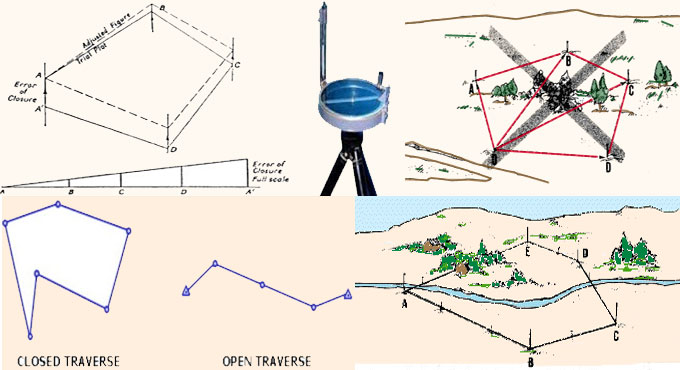
10 Definitions You Must Know About Compass Traversing
In chain surveying, the region to be surveyed is isolated into various triangles. This technique is appropriate considering the cross, an anticlockwise way is constantly useful in running the review lines for genuinely level ground covering little regions. In any case, when the zone is huge, undulating and swarmed with numerous subtleties, triangulation is beyond the realm of imagination. In such a zone, the strategy for compass traversing is embraced.
In traversing, the system consists of various connected lines. The lengths are measured by chain or tape and the directions distinguished by angle-measuring instruments. In one of the techniques, the angle measuring instruments utilized is the compass. Thus, the procedure is known as compass traversing.
Now let us see the 10 most important compass definitions you have to know in surveying.
1. True meridian: The line or plane going through the geological north post, topographical south shaft and any point on the outside of the earth, is known as the 'true meridian' or 'topographical meridian'.
The true meridian at a station is constant. The true meridians going through various points on the earth's surface are not equal, however converge towards the shafts.
Be that as it may, for surveys is little territory, the true meridians going through various points are accepted equally. The angle between the true meridian and a line is known as 'true bearing' of the line. It is otherwise called the 'azimuth'.
2. Magnetic meridian: Right when an appealing needle is suspended wholeheartedly and balanced really, unaffected by alluring substances, it demonstrates a bearing. This heading is known as the 'attractive meridian'. The point between the alluring meridian and a line is known as the 'appealing bearing' or simply the 'bearing' of the line.
3. Self-assertive meridian: Now and again for the survey of little regions, a convenient direction is accepted as a meridian, known as the 'self-assertive meridian'. Now and again the beginning line of a survey is taken as the subjective meridian. The angle between the discretionary meridian and a line is known as the 'subjective bearing' of the line.
4. Grid meridian: A portion of the time, for setting up a guide some state organizations expect a couple of lines corresponding to the certified meridian for a particular zone. These lines are named as 'structure lines' and the central line the 'arrange meridian'. The heading of a line with respect to the network meridian is known as the 'structure bearing' of the line.
5. Designation of magnetic bearing
i) Whole Circle Bearing (WCB): The magnetic bearing of a line measured clockwise from the north shaft towards the line, is known as the 'whole circle bearing', of that line. Such a bearing may have an incentive somewhere in the range of 00 and 3600. The whole circle bearing of a line is gotten by a kaleidoscopic compass.
ii) Quadrantal Bearing (QB): The magnetic bearing of a line measured clockwise or counterclockwise from the North Pole or South Pole (whichever is closer the line) towards the East or West, is known as the 'quadrantal bearing' of the line. This framework consists of four quadrant) Quadrantal Bearing (QB s ? NE, SE, SW and NW. The estimation of a quadrantal bearing lies somewhere in the range of 00 and 900, however the quadrants ought to consistently be mentioned. Quadrantal bearings are acquired by the surveyor's compass.
6. Reduced bearing (RB): At the point when the whole circle bearing of a line is converted to quadrantal bearing. It is named the 'reduced bearing'. In this manner, the reduced bearing is like the quadrantal bearing. It's worth lies somewhere in the range of 00 and 900, however the quadrants ought to be mentioned for legitimate designation.
7. Fore and back bearing: The bearing of a line measured in the direction of the advancement of survey is known as the 'fore bearing' (FB) of the line.
The bearing of a line measured in the direction opposite to the survey is known as the 'back bearing' (BB) of the line.
8. Magnetic declination: The horizontal angle between the magnetic meridian and true meridian is known as 'magnetic declination'. At the point when the north finish of the magnetic needle is pointed towards the west side of the true meridian, the position is named 'Declination West'.
At the point when the north finish of the magnetic needle is pointed towards the east side of the true meridian, the position is named 'Declination East'.
9. Isogonic and agonic lines: Lines going through points of equivalent declination are known as 'isogonic' lines. Lines going through points of zero declination are known as 'agonic' lines.
The Survey of India Department has masterminded a guide of India in which the isogonic and agonic lines are shown up generally speaking to coordinate the compass review in different bits of the nation.
10. Plunge of the magnetic needle: If, despite everything that a needle is perfectly balanced before magnetisation, it doesn't remain in the reasonable position after it is energized. This is a direct result of the appealing effect of the earth. The needle is seen to be inclined towards the post. This propensity of the needle with the level is known as the 'plunge of the alluring needle'.
It is found that the north finish of the needle is occupied downwards in the northern portion of the globe and that the south end is stayed away from downwards in the southern side of the equator. The needle is only even at the equator. To modify the dive of the needle, a rider (metal or silver circle) is outfitted alongside it. The rider is set over the needle at a suitable position to make it level.


